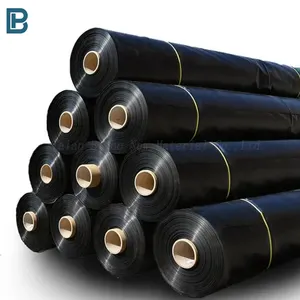Maintaining your 0.75 mm dam liners is crucial for ensuring the longevity of your agricultural pond. These liners are an investment, offering reliable water containment for irrigation, fish farming, and other agricultural purposes. Proper maintenance not only extends the lifespan of your dam liner but also prevents costly repairs and ensures uninterrupted agricultural operations.
In this comprehensive guide, we’ll explore maintenance tips for 0.75 mm dam liners, discuss common challenges, and provide actionable advice for optimal performance. We’ll also integrate insights on related topics like installation best practices, benefits of using geomembrane liners, and environmental considerations.
Understanding 0.75 mm Dam Liners
Dam liners made of HDPE (High-Density Polyethylene) or LLDPE (Linear Low-Density Polyethylene) are widely used in agricultural applications due to their durability, flexibility, and cost-effectiveness. The 0.75 mm thickness strikes a balance between strength and affordability, making it a popular choice for medium-sized agricultural ponds.
Before diving into maintenance tips, let’s briefly touch on why this specific liner thickness is suitable:
- Resilience: Withstands UV radiation and weather extremes.
- Flexibility: Adapts to uneven pond surfaces.
- Waterproofing: Provides superior containment, preventing seepage.
To maximize these benefits, regular maintenance is key.
Essential Maintenance Tips
1. Regular Inspections
Frequent inspections are the cornerstone of maintaining your dam liner. Check for:
- Punctures or tears: Look for visible damage caused by sharp objects or animal activity.
- Seam integrity: Ensure seams remain bonded without separation.
- UV degradation: Inspect for discoloration or brittleness caused by prolonged sun exposure.
Use a liner-friendly patch kit for small punctures, ensuring the adhesive is compatible with the liner material.
2. Keep the Pond Clean
Debris like fallen branches, sharp stones, and organic matter can compromise your liner’s integrity. To prevent damage:
- Remove debris regularly.
- Install protective barriers, such as nets or screens, to minimize external contaminants.
3. Monitor Water Levels
Maintaining optimal water levels reduces stress on the liner. Extreme fluctuations can strain the material, causing it to stretch or weaken.
For accurate monitoring, invest in a pond water level sensor or manually track changes weekly.
4. Protect Against UV Rays
Although most HDPE dam liners are UV-resistant, extended exposure can degrade even the best materials. Consider:
- Adding a thin layer of soil or gravel on top of the liner.
- Using floating plants like duckweed or water lilies for natural shading.
5. Prevent Animal Damage
Wild animals and livestock can damage liners by scratching, biting, or trampling them.
- Fence off the pond area to restrict access.
- Install bird netting to deter waterfowl, which may peck at the liner.
For fish farming applications, ensure that species like carp or catfish don’t burrow into the liner.
6. Avoid Chemical Damage
While dam liners are resistant to most chemicals, prolonged exposure to harsh substances like fertilizers or pesticides can weaken the material.
- Use eco-friendly alternatives where possible.
- Clean the liner periodically with a mild, non-abrasive detergent.
Troubleshooting Common Problems
1. Persistent Leaks
Leaks are often caused by punctures or poor seam welding. Use a leak detection system to pinpoint issues. Repair them promptly using heat welding or adhesive patches.
2. Algae Growth
Algae can make the liner slippery and degrade its surface over time. Minimize growth by:
- Reducing nutrient runoff into the pond.
- Introducing natural algae eaters like grass carp.
3. Folding or Wrinkling
Improper installation may cause folds that trap debris or weaken the liner. Flatten the folds during installation, and consult professionals if significant adjustments are needed.
Additional Benefits of Proper Maintenance
Maintaining your 0.75 mm dam liner goes beyond just preserving its functionality. It also:
- Reduces costs: Avoid expensive repairs or replacements.
- Improves efficiency: Maximizes water storage and prevents seepage.
- Supports sustainability: Prevents water loss, conserving this precious resource for agricultural use.
Key Tools for Maintenance
Invest in the following tools for effective dam liner care:
- Pond skimmers: For debris removal.
- UV protection covers: To shield liners from the sun.
- Liner repair kits: For quick fixes.
Read more about essential tools for pond maintenance here.
Case Study: Successful Maintenance in Action
A farmer in Kenya installed a 0.75 mm dam liner for irrigation purposes. By following regular maintenance routines like those outlined above, they extended the liner’s lifespan from 8 years to 15 years. This simple yet consistent effort saved them over $5,000 in repair costs while ensuring steady water supply for their crops.
Environmental Considerations
Agricultural ponds play a vital role in supporting sustainable farming practices. By maintaining your dam liner:
- You minimize water wastage.
- You prevent soil erosion around the pond.
- You support local biodiversity by creating stable aquatic habitats.
Expert Tips for Installation and Maintenance
For those planning to install or replace their dam liners, consider these expert tips:
- Hire professionals: Proper installation ensures a wrinkle-free, leak-proof fit.
- Choose quality materials: Opt for reputable brands with proven durability.
- Integrate drainage solutions: Prevent waterlogging and reduce stress on the liner.
Discover top-rated dam liner suppliers.
Commonly Asked Questions
1. How often should I inspect my dam liner?
Inspect your dam liner at least once every three months, and after extreme weather events.
2. Can I repair a torn dam liner myself?
Yes, small tears can be repaired using an adhesive patch. For larger damage, consult a professional.
3. What’s the lifespan of a 0.75 mm dam liner?
With proper maintenance, a 0.75 mm HDPE dam liner can last 10–15 years or longer.
Ready to upgrade your agricultural pond with a reliable 0.75 mm dam liner? At [Your Business Name], we offer premium-quality liners, expert installation, and maintenance support to ensure your ponds remain efficient and durable for years to come.
👉 Contact – Prime Variable Covers to get a free quote and expert advice tailored to your agricultural needs!
Originally posted 2024-12-08 17:17:00.

